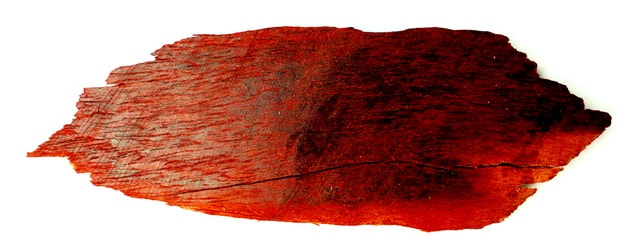Pterocarpus, Red Sandalwood
Raktachandana, Raktasaara (Ayurvedic)
Sandal Surkh, Sandal-e-Ahmar (Unani)
Tsan dan dmar po ཙན་དན་དམར་པོ (Tibetan)
Shivappu-Chandanam (Siddha)
Sandal Surkh, Sandal-e-Ahmar (Unani)
Tsan dan dmar po ཙན་དན་དམར་པོ (Tibetan)
Shivappu-Chandanam (Siddha)
Medical Botany, Woodville, Hooker, Vol. 3, 1832
Red Sandalwood
(Adam, 2017)
(Adam, 2017)
Botanical name:
Pterocarpus santalinus (syn. Santalum rubrum)
Parts used:
Wood
Temperature & Taste:
Cool, dry. Bitter, Sweet.
Classifications:
2F. PURIFYING. 2P. HEMOSTATICS
3B. FEBRIFUGE & ANTIPYRETIC
Pterocarpus santalinus (syn. Santalum rubrum)
Parts used:
Wood
Temperature & Taste:
Cool, dry. Bitter, Sweet.
Classifications:
2F. PURIFYING. 2P. HEMOSTATICS
3B. FEBRIFUGE & ANTIPYRETIC
Uses:
1. Clears Heat from the Blood, Resists Poison:
-Fevers.
2. Clears Heat, Stops Bleeding:
-heat-type Bleeding
3. Clears Heat, Astringes to Stop Leakage:
-Diarrhea
4. Clears Heat from the Heart:
-Heart debility
5. Coloring:
-Often used as a coloring matter for tinctures, spirits and decoctions etc.
6. Externally:
-all types of inflammation
Dose:
Powder: 2–5 grams;
Corrective:
... available in PRO version
Substitute:
... available in PRO version
Comment:
... available in PRO version
Powder: 2–5 grams;
Corrective:
... available in PRO version
Substitute:
... available in PRO version
Comment:
... available in PRO version
Main Combinations:
1. For Stomach and Liver Heat with Qi stagnation, 3 Sandalwoods with ... available in PRO version
2. For Catarrh, Consumption, Spitting Blood, and Diarrhea, 3 Sandalwoods with ... available in PRO version
3. To clears Liver Heat, ... available in PRO version
4. To clear Liver Heat, and Heat in general, White and Red Sandalwood, ... available in PRO version
5. For Arthritis, Lower Back and Hip pain, Heat and inflammation, Red Sandalwood, ... available in PRO version
6. As a paste for skin spots, freckles and discolorations, ... available in PRO version
Major Formulas:
Powder to Cool the Heart
Powder to Cool the Liver
Powder for the Liver (Bononiense)
Cordial Powder
Troches of Sandalwoods (Trochisci Santalon) (Mesue)
Troches of Rose (Trochisci Diarrhodon)(Nicholas)
Electuary of the Juice of Roses (Mesue)
Electuarium Dianthu (Galen)
Sandalwood 18 (Tibetan Medicine)
Cautions:
1. In TCM, Sandalwood is not used in Deficient-Heat conditions. It is suitable for these conditions when combined with appropriate medicines as is evident from other Traditions.
2. All Sandalwoods decrease sexual activity with long-term use or in large doses.
CITES listing:
This medicine is listed on CITES as endangered.
Main Preparations used:
1. In TCM, Sandalwood is not used in Deficient-Heat conditions. It is suitable for these conditions when combined with appropriate medicines as is evident from other Traditions.
2. All Sandalwoods decrease sexual activity with long-term use or in large doses.
CITES listing:
This medicine is listed on CITES as endangered.
Main Preparations used:





